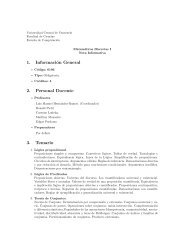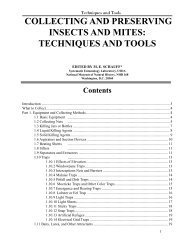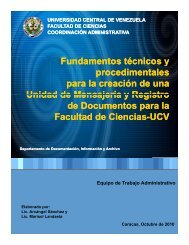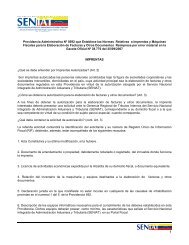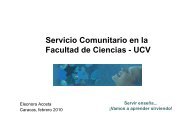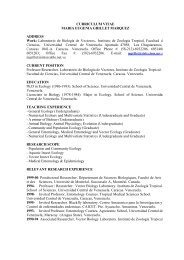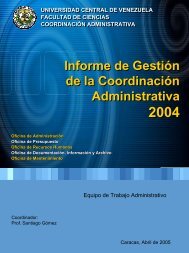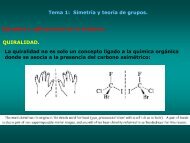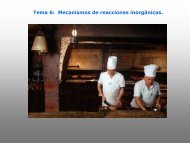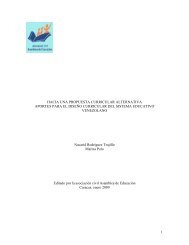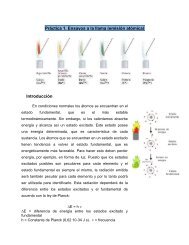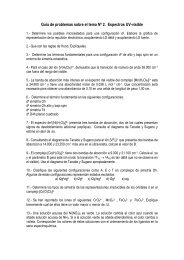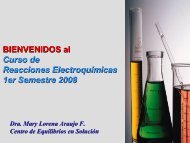Loop-mediated isothermal amplification test for Trypanosoma vivax ...
Loop-mediated isothermal amplification test for Trypanosoma vivax ...
Loop-mediated isothermal amplification test for Trypanosoma vivax ...
- No tags were found...
You also want an ePaper? Increase the reach of your titles
YUMPU automatically turns print PDFs into web optimized ePapers that Google loves.
G ModelVETPAR-5767; No. of Pages 5ARTICLE IN PRESS2 Z.K. Njiru et al. / Veterinary Parasitology xxx (2011) xxx–xxx(Desquesnes, 1996). Molecular based <strong>test</strong> (PCR) promisedbetter sensitivity and a range of them were developed(Masiga et al., 1992; Masake et al., 1997; Morlais et al.,2001) but the demanding nature of PCR technique has limitedits use in routine diagnosis. Nevertheless due to lowparasitaemia and difficulties in propagating T. <strong>vivax</strong> in mice,PCR has remained the most appropriate method <strong>for</strong> laboratorybased diagnosis (Jones and Dávila, 2001). To datea definitive field based assay <strong>for</strong> T. <strong>vivax</strong> has been elusive,there<strong>for</strong>e it is essential to continue evaluating newdiagnostic technologies and especially those that offer plat<strong>for</strong>ms<strong>for</strong> developing point of use <strong>test</strong>s.<strong>Loop</strong>-<strong>mediated</strong> <strong>isothermal</strong> <strong>amplification</strong> (LAMP) is anovel gene <strong>amplification</strong> method that amplifies DNA under<strong>isothermal</strong> conditions (Notomi et al., 2000). The techniqueuses four to six primers that recognize six to eight regionsof the target DNA and relies on Bst DNA polymerase, anenzyme that synthesizes DNA through strand displacementactivity. The LAMP method has several advantages over PCRin that: (i) LAMP <strong>amplification</strong> can be achieved using simpleheating device that maintains temperature at <strong>isothermal</strong>(60–65 ◦ C), (ii) <strong>amplification</strong> can be achieved using partiallyor non-processed template (Kaneko et al., 2007; Njiruet al., 2008) there<strong>for</strong>e DNA extraction may not be necessary,(iii) reactions are rapid and require shorter time (Nagamineet al., 2002), (iv) sensitivity is equal or higher than that ofPCR and (v) the technology allows the use of varied productdetection <strong>for</strong>mats. These characteristics make LAMP strategyideal <strong>for</strong> T. <strong>vivax</strong> diagnosis in resource poor endemicregions. In this study, we have designed a rapid T. <strong>vivax</strong>LAMP <strong>test</strong> based on the satellite repeat DNA. The nuclearsatellite repeat sequence is a desired target because it ismulticopy gene and widely conserved among T. <strong>vivax</strong> isolatesin Africa and S. America. The <strong>test</strong> was evaluated andcompared with PCR <strong>test</strong>s using a panel of T. <strong>vivax</strong> isolatesand archived field samples.2. Materials and methods2.1. Preparation of templateA total of 23 T. <strong>vivax</strong> samples collected from Kenya,Uganda, Tanzania and Nigeria from bovine and tsetseflies between 1951 and 1991 were used in this study.The samples included three hemorrhagic T. <strong>vivax</strong> samplesfrom Kenya. The DNA was prepared using the QiagenDNeasy blood and tissue kit and following the manufacturerinstructions. The resulting DNA was stored at −20 ◦ C.2.2. Polymerase chain reactionThe PCR <strong>test</strong> reactions <strong>for</strong> satellite repeat DNA (Masigaet al., 1992) and diagnostic antigen gene (Masake et al.,1997) were done using the published conditions. A thirdPCR <strong>for</strong> satellite repeat DNA was per<strong>for</strong>med using outer<strong>for</strong>ward (F3) and backward (B3) LAMP primers. The newPCR <strong>test</strong> was per<strong>for</strong>med using a 25 l reaction consistingof 1× PCR buffer, 200 M of each dNTP, 1.5 mM of MgCl 2 ,12.5 pmol of each F3 and B3 primers, 1 U Taq DNA Polymerase(Fisher Biotec, WA, Australia) and 1-l of DNAtemplate. The reactions were done in duplicates using a96-Well GeneAmp ® PCR System 9700 (Applied Biosystems,Australia) at: 1 cycle 95 ◦ C <strong>for</strong> 10 min, followed by 40 cyclesof 94 ◦ C <strong>for</strong> 45 s, 63 ◦ C <strong>for</strong> 30 s and 72 ◦ C <strong>for</strong> 30 s and a finalextension at 72 ◦ C <strong>for</strong> 10 min. After <strong>amplification</strong>s, 10-lofthe PCR products were resolved <strong>for</strong> 70 min in 2.0% agarosegel stained with SYBR ® safe DNA gel stain (Invitrogen, Victoria,Australia). The gel images were documented usingGel- Doc-XR system (Bio-Rad Lab).2.3. LAMP primers and reactionT. <strong>vivax</strong> satellite repeat DNA (Accession number J03989)was used <strong>for</strong> designing six LAMP primers. The primerswere <strong>for</strong>ward and backward primers: F3 = TGTTCTGGTGG-CCTGTTGC and B3 = GGCCGGAGCGAGAGGTGC, <strong>for</strong>wardand backward inner primers: FIP = GTGGAGCGTG-CCAACGTGGCACCCGCTCCCAGACCATA and BIP = TGTCT-AGCGTGACGCGATGGAAGAGGGAGTGGGGAAGG and loop<strong>for</strong>ward and backward primers: CACATGGAGCATCAGGACand LB: CCGTGCACTGTCCCGCAC. The LAMP <strong>test</strong>s werecarried out in 25-l reactions consisting of 5 pmol ofthe outer primers, 20 pmol of loop primers, 40 pmol ofthe inner primers, 4 mM of extra MgSO 4 , 1 M betaine(Sigma–Aldrich, St. Louis, MO, USA) and 2.5 mM deoxynucleotidetriphosphates mix (dNTP). The 1× ThermoPolreaction buffer contained 20 mM Tris–HCl (pH 8.8), 10 mMKCl, 10 mM (NH 4 ) 2 SO 4 , 2 mM MgSO 4 and 0.1% TritonX-100. The Bst DNA polymerase (Large fragment; NewEngland Biolabs, MA, USA) was 1 l (8 units) while SYTO-9fluorescence dye at 1.5 M (Molecular Probes, OR USA)was used <strong>for</strong> each real time reaction. The template was1-l (∼1 ng) of T. <strong>vivax</strong> isolate EATRO 1186. The mixturewas incubated at 63 ◦ C in the Rotor-Gene 6000 (Qiagen,Victoria, Australia) and data acquired on HRM channel(460–510 nm) followed by reaction inactivation at 80 ◦ C<strong>for</strong> 4 min. Later the assay was trialed using a normal waterbath. Briefly, water was heated to ∼63–64 ◦ C and the LAMPreaction tubes suspended in water using a floater <strong>for</strong> 1 h,after which the temperature was raised to approximately80 ◦ C to stop the reactions. To select an appropriaterestriction enzyme <strong>for</strong> product analysis, the targetsequence was analyzed using restriction enzyme mapperin DNAman software (Lynnon Corporation, Quebec,Canada).2.4. Detection and confirmation of LAMP productThe LAMP reactions were monitored in real timethrough fluorescence of double stranded DNA (dsDNA) inRotor-Gene 6000. After <strong>amplification</strong>, the products werefurther analyzed through electrophoresis in 2.0% agarosegels stained with SYBR ® safe DNA gel stain and throughaddition of 1/10 dilution of SYBR ® Green I. Two methodswere used to confirm that the T. <strong>vivax</strong> LAMP amplifiedthe correct target: (i) the melt curves were acquired using1 ◦ C step, with a hold of 30 s, from 63 ◦ Cto96 ◦ C and (ii)1–2 l of the <strong>amplification</strong> product was incubated withrestriction enzyme NdeI (New England Biolabs, MA, USA)at 37 ◦ C <strong>for</strong> 4 h followed by electrophoresis in 3% agarosegel.Please cite this article in press as: Njiru, Z.K., et al., <strong>Loop</strong>-<strong>mediated</strong> <strong>isothermal</strong> <strong>amplification</strong> <strong>test</strong> <strong>for</strong> <strong>Trypanosoma</strong> <strong>vivax</strong>based on satellite repeat DNA. Vet. Parasitol. (2011), doi:10.1016/j.vetpar.2011.03.021



